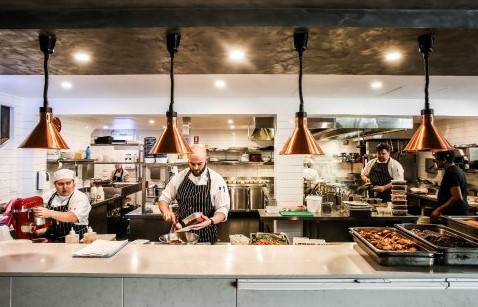Efficiency is crucial when managing a commercial kitchen, so you need to have a solid design in mind when planning your kitchen. Your staff need to be able to perform their job to the best of their capabilities, meaning that they need to be able to do their tasks without obstructing one another. For this reason, you need to select the optimal kitchen plan for your requirements.
No matter the size of your space, you will need to make the most of what you have. A strong kitchen design will improve stall collaboration and aid food preparation.
But what are the most common layouts for commercial kitchens? And which layout is the best for your kitchen?
1. The Kitchen Island Layout
With this type of restaurant kitchen layout, the chefs and the food are the stars of the show; they take centre stage and can often be seen by restaurant guests. All of the cooking equipment is centred in and around the island section. And other sections, such as the food preparation area and dishwashing area, will be pushed to the kitchen’s perimeter.
2. The Open Kitchen Layout
The open kitchen layout is a popular way to alter the atmosphere of traditional restaurants. By using an open kitchen layout, diners are able to watch chefs as they prepare their meals. This layout often features a glass partition to segment the cooking area from the dining area.
3. The Assembly Line Layout
The assembly line layout is typically incorporated into a restaurant in order to improve efficiency of food assembly. This type of kitchen layout is best used when your business needs fast, high volume food production. Meaning that it is great for fast food restaurants and catering services. Subway is an example of a restaurant that uses an assembly line kitchen layout; it allows customers to customise their meal as it is prepared. Subway and similar restaurants often require customers to pay at the end of the line on a POS tablet. In addition to this, they have online orders to prep, assemble and package, so speed is key.
4. The Zoning Layout
“Zoning” signifies separating a kitchen into different areas based on the type of dish that is made. A zone layout means that staff are able to assemble a bigger range of meals, more so than a traditional commercial kitchen. It also improves kitchen flow by providing lots of open areas for staff to move between.
5. Small Commercial Kitchen Designs
Sometimes we don’t have a lot of space to work with, but you can still create an efficient space by maximising the potential of your small commercial kitchen. Consider the most important equipment that you need to run your kitchen, and prioritise placing them in a logical manner. Consider the workflow of your staff to ensure that they can easily reach everything they need.
What Constitutes an Efficient Restaurant Kitchen Layout
In addition to the layout of your commercial kitchen, you need to take the following considerations into account to ensure that your space is optimal and safe.
Make Use of the Space You Have
Designing and arranging your restaurant kitchen so that the equipment is easily accessible is one of the best ways to use your space ergonomically. You must take into consideration how much equipment the kitchen will need to hold in order to be effective. Consider how many people will be in the kitchen, storage, and which direction your chefs will be moving between stations.
Staff Workflow
When designing your restaurant kitchen layout, it’s important to consider how people will interact with your space. Facilitate your staff’s workload by making interaction, movement and communication easier with a functional layout. An open floor plan will make this easier, and a poorly designed maze-like kitchen will make it difficult. Taking your staff into consideration is key to designing a kitchen layout that works for you.
Safety
Safety should be your first priority when designing a commercial kitchen layout. Both food safety and personal safety need to be incorporated into your design. Design a space that keeps food safe for consumption, with adequate cool storage areas. You can also place your delivery area near the fridge and freezer to avoid food being unrefrigerated for long periods of time. Check food safety regulations in your country or region, as local regulations may determine how you set up your kitchen.
In terms of keeping your staff safe, there are multiple precautions you need to take when designing your kitchen. Things to keep in mind when are:
- Ventilation systems should installed in your kitchen
- Fire exits are easily accessible
- Safety points should be established and made clear from day 1
- Install smoke detectors & fire extinguishers
Conclusion
An effective restaurant kitchen design should be at the top of your list of priorities whether you’re starting a new restaurant, operating a second restaurant, or remodelling an existing restaurant. Take into account the flow of traffic and how your staff will move throughout the space. You also want to make sure that there is enough room for all of your desired features and amenities. Kitchen design software can alleviate the stress involved with planning.
Your restaurant’s heart and soul are in the kitchen, where the cooks prepare the meals. The success of a restaurant depends on having elegantly designed commercial kitchens with all the necessary restaurant equipment located exactly where the cooks need it.
Additionally, consider what kind of technology you want to use to design your commercial kitchen. Specifi Design is the foodservice industry’s most advanced kitchen design software. Loaded with time-saving features for AutoCAD & Revit/BIM to make it easier to design your commercial kitchen to your specifications.


